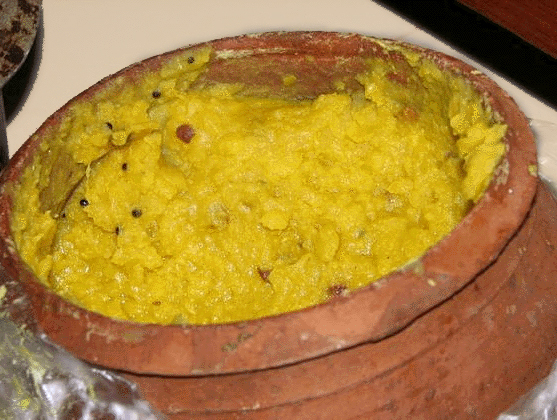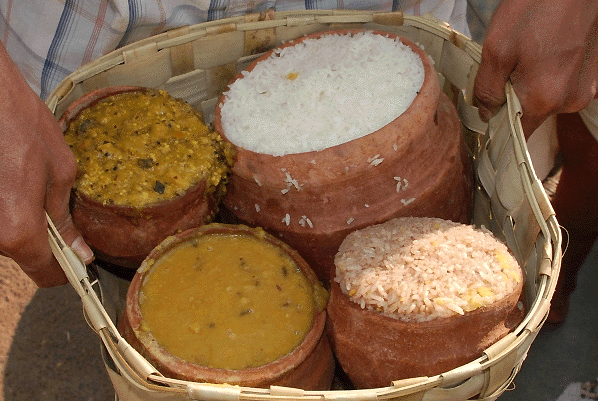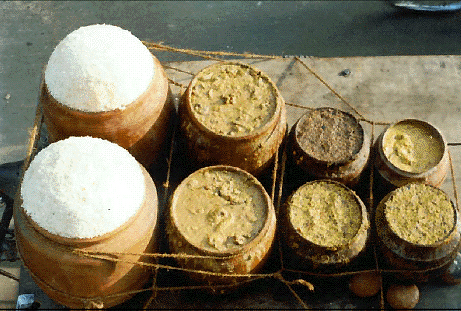
|
|
|
|
BY: SUN STAFF

Puri Dal Mahaprasad Jun 15, 2011 — CANADA (SUN) — A three-part summary of Mahaprasad at Jagannath Temple. In the broad sense, everything that is touched or used by the Deities of Sri Jagannath Temple is considered to be Mahaprasad, not only the foodstuffs. This includes tulsi leaves, bath water of the Deities, called paduka, cloth, and everything else that is used by the Deities. All Mahaprasad is surcharged with spiritual energy – the mercy of the Lord of the Universe. If someone is sick, Mahaprasad is given for healing. By taking Mahaprasad daily, it is believed that one can avoid suffering from disease in this life. When cured of incurable illnesses, people will feed 7, 21 or 108 poor Brahmins, according to their resources. Mahaprasad is also called nirmalya, meaning 'that which makes one completely pure like a lotus'. Another name for Mahaprasad is kaibalya, or that which gives moksa, or liberation. The poet Salabega, a famous Muslim devotee of Lord Jagannath, sang of his longing to take Mahaprasad. Mahaprasad is most always thought of by the devotees when they think of Lord Jagannath. In his famous Oriyan bhajan, Salabega wrote: thaka mana chala jiba Let us go to Puri, In order to seal a promise, two friends will be seen holding a clay pot of Mahaprasad between them, eating together from the same pot. This shared pot is called abadha, meaning 'that which cannot be taken away or put into another pot'. The friends will exchange this vow: "You are my Mahaprasad, You are my Abadha." When they see each other in the future, they will address each other as "Abadha" only -- that which cannot be taken away. During the month of January, Mahaprasad is sometimes referred to as pahili bhoga. Those wishing to take Mahaprasad at this time will say, "Let us take Pahili Bhoga. This special Mahaprasad is taken in memory of the morning bhoga offered to Lord Jagannath during this month. Traditionally, at this time of year wives visit their mother's house for a few days, just as Laksmi Devi goes to Her mother's house, also.
The Mothers must feed Jagannath just as Mother Yasoda feeds baby Krishna.

Pahili Bhoga Pahili Bhoga is typically the first food given to a baby, and may be of two types. One is very tiny balls made of bin dal, while the second is very soft khechedi rice. This prasad cannot be eaten afterwards by devotees, and it must be offered just at dawn. This practice makes seva somewhat more difficult for the sevakas, because all the morning rituals must be completed before dawn, and there is added ritual when Lord Jagannath as baby Krishna eats the special ballaba bhoga. The atmosphere in Lord Jagannatha's temple kitchen is a remarkable phenomenon. Not only is it the largest temple kitchen in the world, but all manner of inconceivable goings-on take place there. Many cooking servants are required in order to produce the more than 56 items offered to Lord Jagannath each day. Clay pots are placed in a special earthen oven, five in number, and one on top of another, yet the one on top is cooked first, not last. Another strange phenomenon is that many times pots are broken on the way to the temple, or the food is spoiled in preparation and must be discarded. When this happens, it is understood that the cook was impure in some way. To cook for God, both body and mind must be purified. When engaging in devotional service in the kitchen, the sevaka must tie a cloth over his mouth while food is being carried to the main temple, so that no human saliva can contaminate the bhoga. If one is feeling proud that he has made a good preparation, it is said that his pot is sure to be broken. It is also understood that if Mother Laksmi is displeased with a cook's preparation, a dog will appear mysteriously on the temple grounds, usually as food is being carried to the Deities. Of course, no dog is allowed to enter the temple. If the dog – known as kutama chandi, a Tantric goddess in charge of purification of food – is seen in the temple compound, then all the food preparations must be buried and prepared again, fresh.

Following are the 56 chapana bhoga, the main preparations offered to Lord Jagannath each day, then distributed as Mahaprasad: RICE PREPARATIONS 1. Sadha Anna - simple rice water SWEETS (usually deep-fried as small balls) 10. Khaja - wheat CAKES, PANCAKES AND PATTIES 21. Suar Pitha - wheat and ghee MILK PREPARATIONS 34. Khiri - milk and sugar with rice DAL AND VEGETABLES 43. Dal This menu of preparations is offered to Lord Jagannath in His Puri abode each day.
| |